Changsha Huanghua International Airport
Changsha Huanghua International Airport (IATA: CSX, ICAO: ZGHA, CAAC LID: HHA)[1] is the airport serving Changsha, the capital of Hunan province, China, as well as nearby cities such as Zhuzhou and Xiangtan. As of 2016, it is the 13th busiest civil airport in China. Located about 25 kilometres (16 mi) from downtown Changsha in the town of Huanghua in Changsha County, the airport has two terminal buildings. The airport is managed by the Hunan Airport Authority, a publicly owned corporation managing all five airports in Hunan Province. Huanghua airport was opened in August 1989, replacing Changsha Datuopu Airport, which is now a military air base.
Changsha Huanghua International Airport | |||||||||||||||
|---|---|---|---|---|---|---|---|---|---|---|---|---|---|---|---|
 | |||||||||||||||
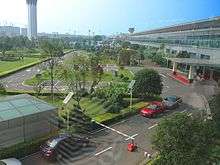 | |||||||||||||||
| Summary | |||||||||||||||
| Airport type | Public | ||||||||||||||
| Operator | Hunan Airport Management Group Co., Ltd. | ||||||||||||||
| Serves | Changsha, Hunan | ||||||||||||||
| Location | Huanghua, Changsha County, Hunan | ||||||||||||||
| Opened | 29 August 1989 | ||||||||||||||
| Focus city for | |||||||||||||||
| Elevation AMSL | 66 m / 217 ft | ||||||||||||||
| Coordinates | 28°11′48″N 113°13′15″E | ||||||||||||||
| Website | csa | ||||||||||||||
| Maps | |||||||||||||||
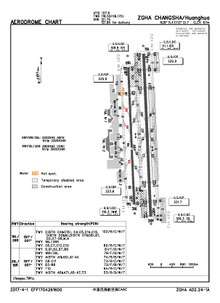 CAAC airport chart | |||||||||||||||
 CSX Location of airport in Hunan 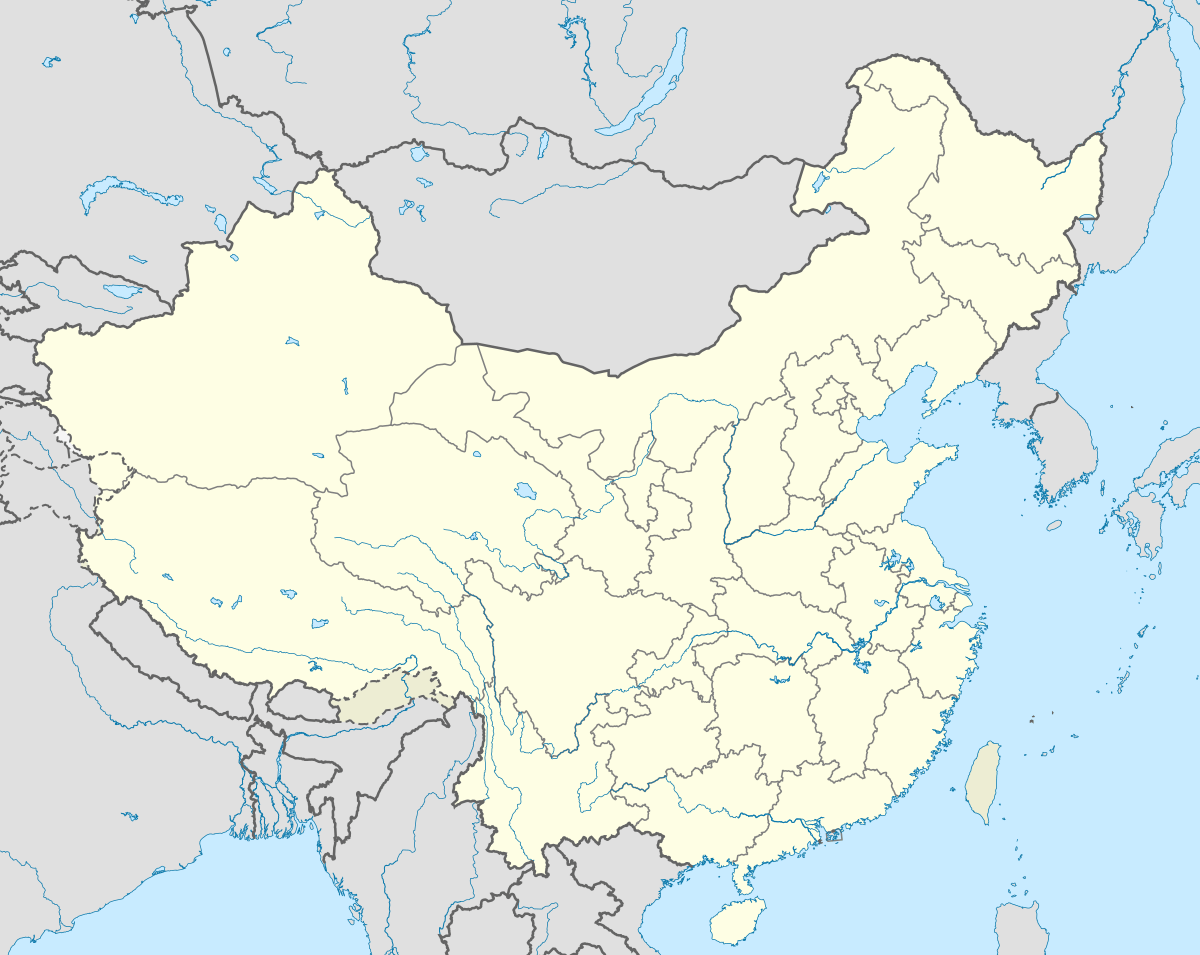 CSX CSX (China) | |||||||||||||||
| Runways | |||||||||||||||
| |||||||||||||||
| Statistics (2018) | |||||||||||||||
| |||||||||||||||
Source: CAAC Central and Southern Regional Administration, List of the busiest airports in the People's Republic of China | |||||||||||||||
| Changsha Huanghua International Airport | |||||||
|---|---|---|---|---|---|---|---|
| Traditional Chinese | 長沙黃花國際機場 | ||||||
| Simplified Chinese | 长沙黄花国际机场 | ||||||
| |||||||
Terminals
Terminal 1
Terminal 1, with 32,000 m2 of space, has 3 concourses (T1-A, T1-B and T1-c). It was opened in 2000, and the proposed capacity was 4.6 million passengers annually. Terminal 1 was closed for renovation from July 2011 to 17 May 2018 after Terminal 2 became fully operational.
Terminal 1 reopened on 18 May 2018. After renovation, Terminal 1 has 39,000 m2 of space, 38 check-in counters, 10 security lanes and 10 aerobridges. It has the capacity of 6 million passengers annually.[2] Terminal 1 serves Air China, Chengdu Airlines, Joy Air, Okay Airways, Tibet Airlines, Shandong Airlines, Shenzhen Airlines and Kunming Airlines.
Terminal 1 and concourses |
Terminal 2
The inauguration of Terminal 2 was on July 19, 2011. With 212,000 square meters of space, the new terminal is the 5th largest airport terminal in mainland China (after Beijing–Capital, Shanghai–Pudong, Guangzhou, and Shenzhen). The 39.9m tall main building of Terminal 2, being 672m in length and 168m in depth, is the largest single steel-truss structure in Hunan. The new terminal has 22 bridge gates, to which the longest passenger walking distance is within 300m. With this new facility, the airport can handle 151,000 aircraft movements and another 15.6 million passengers every year. The peak hour volume of passengers is 3,940.
The Departure Hall has 4 automatic double-glass-door entrances which are directly facing Check-in Areas A,B,C & D respectively. Entrances 1-3 are domestic entrances and Entrance 4 is for International, Hong Kong, Macau and Taiwan Departures, which will be checked in at Area D. Area A is the exclusive check-in Area for China Southern Airlines. Area B&C are domestic check-in areas for other airlines. The terminal has 80 check-in counters and 24 self-checkin kiosks, 24 security checkpoints and more than 6,390 seats.
The Arrival Hall is equipped with 8 baggage carousels (6 at domestic area and 2 at international area). The indoor parking garage P4, which has 693 parking spaces, is on floor B2. There are also three outdoor parking areas, P1,2&3, which provide over 1000 parking spaces.
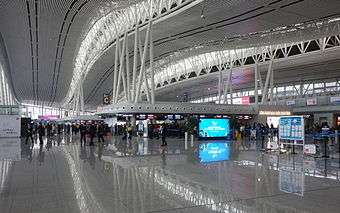 Terminal 2 Departure Hall |
 International area inside Terminal 2 |
History
From 1957 to 1989, Datuopu Airport served as a dual-use military and civil airport for Changsha. It was only capable of handling small aircraft and a few flights per day. The Hunan Provincial Government proposed the construction of a new airport in October 1984, which was approved by the State Council of China. Construction for Huanghua Airport began in June 1986, and it was opened on 29 August 1989, when all civil flights were transferred to the new airport, and Datuopu reverted to sole military use.[3][4]
On October 28, 2000, the 34,000-square-meter Terminal 1-A, which cost 40.4 million CNY, was opened. The airport was capable of handling 4.6 million passengers per year. Afterwards, the construction of Terminal 1-B and Terminal 1-C were finished to ensure growing passengers and cargo.
The airport then went through a major expansion in 2008–2011, with lengthening of runway 18/36 from 2600m to 3200m and the addition of Terminal 2 which went into operation in 2011. The airport welcomed its first intercontinental destination when China Southern Airlines began service to Frankfurt, Germany on 23 June 2014.[5]
The construction of the second runway was completed in November, 2016. The new 3800mx60m Code-4F runway was built parallel to the current 18/36 runway and lies 380m to the east. The second runway officially came into use on March 30, 2017. The new runway means that Huanghua Airport is now ranked as a 4F, the highest level for an airport, and capable of accommodating wide-body aircraft such as the A380.
On May 16, 2018, the renovated Terminal 1 of the Changsha Huanghua International Airport resumes operation. The domestic flights operated by Air China, Shenzhen Airlines, Shandong Airlines, Chengdu Airlines, Kunming Airlines, Okay Airways, Joy Air, and Tibet Airlines arrive at T1.



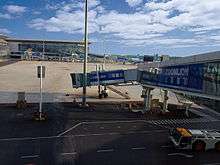
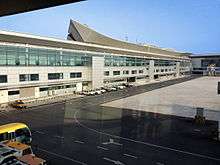
Short-Term Expansion (2030)
The airport is undergoing a major expansion eastwards. After the completion of the 2nd runway, Terminal 3 and the east terminal area will be constructed on the east side of airport, with 500,000 square meters of space. The airport will be capable of handling 60 million passengers annually and an annual cargo capacity of 6 million tons. The airport becomes a hub in Central China after this stage. A third runway of 3600m*45m in length and a GTC with 280,000 square meters of space will also be constructed and ready for use in 2024.
Long-Term Expansion (2050)
Terminal 4 is to be constructed on the north side of the East terminal area. The east terminal area, in which both Terminals 3&4 lie, is located between the 2nd and 3rd Runways. At the final stage, the fourth parallel runway (3600m) of 4E will be constructed 1035m in the east of the third runway. Two tunnels connecting the west area (Terminal 1&2) and the east terminals (Terminal 3&4) are considered.
Changsha Huanghua Int'l airport will become a major hub in China which hosts a number of based airlines. The ultimate capacity of the airport will be 90 million passengers annually.
Airlines and destinations
Statistics
As for 2016, Changsha Huanghua International Airport was the 13th busiest airport in the People's Republic of China with 21,296,700 passengers.
| Year | Passengers | % Change | Cargo (tons) | Aircraft Movements |
|---|---|---|---|---|
| 2017 | 23,764,820 | 138,737.6 | 179,575 | |
| 2016 | 21,296,675 | 130,276.1 | 167,910 | |
| 2015 | 18,715,278 | 122,022.1 | 153,367 | |
| 2014 | 18,020,501 | 125,037.8 | 152,359 | |
| 2013 | 16,007,212 | 117,588.7 | 137,843 | |
| 2012 | 14,749,701 | 110,608.0 | 127,041 | |
| 2011 | 13,684,731 | 114,831.1 | 116,727 | |
| 2010 | 12,621,333 | 108,635.2 | 115,635 | |
| 2009 | 11,284,282 | 86,995.0 | 110,023 | |
| 2008 | 8,454,808 | 71,151.9 | 85,339 | |
| 2007 | 8,069,989 | 68,629.7 | 82,041 | |
| 2006 | 6,592,602 | 62,571.3 | 71,139 | |
| 2005 | 5,301,396 | 52,360.3 | 59,534 | |
| 2004 | 3,802,550 | 43,133.2 | 55,054 | |
| 2003 | 2,992,543 | 34,987.5 | 46,993 | |
| 2002 | 2,598,508 | 25,437.9 | 42,920 | |
| 2001 | 2,217,088 | 20,375.2 | 39,194 | |
| 2000 | 2,034,526 | - | 18,552.0 | 37,722 |
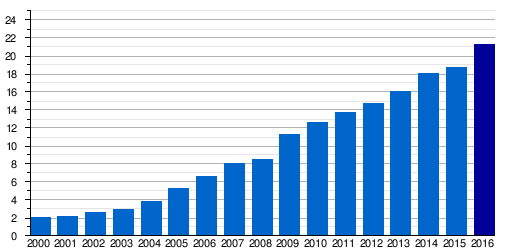 |
Ground transportation
 Interior of Changsha Maglev train (2016)
Interior of Changsha Maglev train (2016) Platform of Huanghua Airport Station (2016)
Platform of Huanghua Airport Station (2016)- Coaches & Buses services
- Waiting Area for coaches & buses
 Driving on Changsha Airport Expressway(S40)
Driving on Changsha Airport Expressway(S40)- Parking Areas in the airport
Maglev
- The regular-speed Changsha Maglev Express connects Changsha Huanghua International Airport and Changsha South railway station, it started operation on 6 May 2016.
- The Maglev line is 18.5 km long and trains and runs at a speed of 120 km/h to finish the journey in just over 10 minutes.[58]
- The ticket price is ¥20 between the Airport and South Railway Station. Metro-card holders can receive a 10% discount.
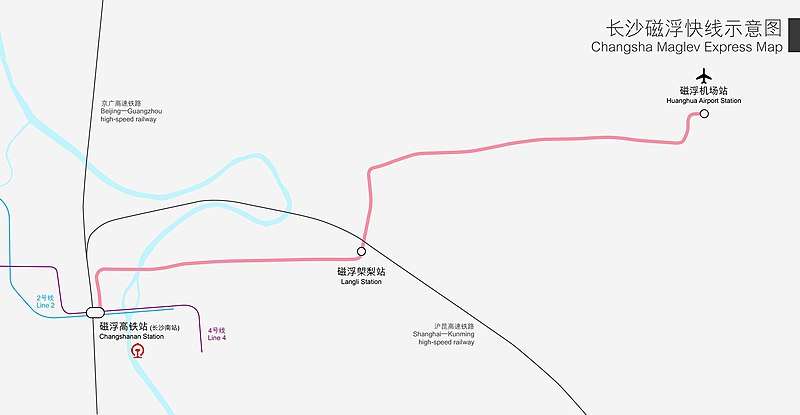
| Station Name English |
Station Name Chinese |
Transfer | Location |
|---|---|---|---|
| Changshanan | 磁浮高铁站 | 2 4 |
Yuhua |
| Langli | 磁浮㮾梨 | Changsha County | |
| Huanghua Airport | 磁浮机场 | 6 (under construction) | |
Metro
- Line 6 of Changsha Metro: under construction.
Bus
- There are direct shuttle buses connecting the airport with Hunan Civil Aviation Hotel (with one stop at Gao Qiao on the way), Changsha South Railway Station, and South Bus Station
Gallery
- Aerial view of Terminal 1 and 2
- Lifts between Departure & Arrival Floors in T2
- Terminal2 screen walls
- Hallway behind the security checking border inside CSX terminal 2
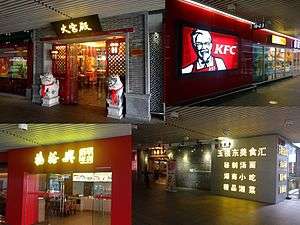 Restaurants in Food Court of T2
Restaurants in Food Court of T2 outside Terminal1
outside Terminal1
See also
References
- "长沙航空口岸". Archived from the original on 2018-01-04. Retrieved 2018-01-09.
- 长沙机场进入双航站楼双跑道运营时代
- Sha, Zhaohua (2018-08-10). "1989年:长沙黄花机场建成通航". Hunan Daily. Retrieved 2018-10-02.
- "30年前,见证黄花机场开建". Huaxia. Retrieved 2018-10-02.
- "China Southern to Open Direct Flight from Changsha to Frankfurt on June 23".
- https://www.flightradar24.com/data/flights/ca4067
- http://m.jdair.net/h5/views/hangxian.jsp
- http://www.caacnews.com.cn/1/6/201903/t20190321_1269735.html
- 东航江苏2018夏秋换季抢先看!
- "China Eastern expands South East Asia Network in S19". routesonline. Retrieved 12 March 2019.
- 新航季东航在烟台威海开通多条新航线
- http://www.sohu.com/a/305008968_396919
- Liu, Jim. "China Southern schedules new Macau routes from late-Oct 2019". Routesonline. Retrieved 4 October 2019.
- https://www.routesonline.com/news/38/airlineroute/285312/china-southern-adds-changsha-nagoya-route-from-august-2019/
- "China Southern adds Changsha – Nairobi service from late-June 2019". routesonline. Retrieved 29 April 2019.
- Liu, Jim. "China Southern adds Changsha – Singapore service in S19". Routesonline. Retrieved 12 March 2019.
- https://www.flightradar24.com/data/flights/hu7537
- http://www.tynews.com.cn/system/2019/05/09/030124065.shtml
- http://lf.sxgov.cn/content/2019-04/02/content_9352731.htm
- "Hainan Airlines adds Changsha – London Heathrow from late-Mar 2018". routesonline. Retrieved 9 March 2018.
- "Hainan Airlines plans Changsha – Melbourne launch in Nov 2016". routesonline. Retrieved 10 September 2016.
- "Hainan Airlines continues Changsha – Sydney service from mid-Sep 2019". routesonline. Retrieved 16 October 2019.
- https://www.flightradar24.com/data/flights/hu7569
- https://www.hnair.com/guanyuhaihang/hhxw/hhxw/201903/t20190327_27389.html
- Liu, Jim. "Himalaya Airlines W19 network adjustment as of 08NOV19". Routesonline. Retrieved 13 November 2019.
- http://www.sohu.com/a/305506533_232219
- "Juneyao Airlines adds Changsha – Osaka from July 2019". routesonline. Retrieved 6 May 2019.
- http://news.carnoc.com/list/486/486711.html
- https://kknews.cc/travel/bb45zo.html
- "Lanmei Airlines continues China expansion in mid-May 2018".
- "Lanmei Airlines schedules new routes in 4Q18".
- "This year there are 37 flights from China to Indonesia Tourism Dive Resort Manado". top-news.top. 22 July 2016. Retrieved 27 July 2016.
- https://www.flightradar24.com/data/flights/gj8884
- https://www.flightradar24.com/data/flights/gj8671
- http://www.caacnews.com.cn/1/6/201903/t20190313_1269112.html
- https://www.flightradar24.com/data/flights/gj8064
- https://www.chinatimes.com/realtimenews/20170908006404-260415
- http://www.xxcb.cn/event/changsha/2019-03-29/9090965.html
- https://moment.rednet.cn/content/2019/04/17/5325633.html
- Liu, Jim. "Okay Airways adds Linyi – Osaka service from Dec 2019". Routesonline. Retrieved 11 December 2019.
- "Okay Airways adds Changsha – Osaka from late-July 2019".
- "Jetstar Pacific Adds New Cam Ranh/Nha Trang – China Charters in W15".
- http://www.sohu.com/a/316187680_395117
- http://news.carnoc.com/list/487/487295.html
- Liu, Jim. "Qingdao Airlines plans new international routes in 4Q19". Routesonline. Retrieved 15 October 2019.
- https://www.flightradar24.com/data/flights/qw6077
- "Royal Brunei begins Changsha service from mid-April 2019".
- https://mp.weixin.qq.com/s/KQIFlF2AKUAM8aWe0vqluA
- Lim, Sean (22 November 2018). "Frequent fliers on some SilkAir routes will soon have to fly Scoot, SIA announces ahead of merger". businessinsider.sg. Archived from the original on 30 October 2019. Retrieved 30 October 2019.
- https://new.qq.com/omn/20190118/20190118A1EJ6I.html
- https://www.flightradar24.com/data/flights/zh8768
- "Thai Lion Air plans Chiang Rai – Changsha launch in August 2017". routesonline. Retrieved 26 July 2017.
- Liu, Jim. "Thai Lion Air plans to resume Utapao – Changsha service in Sep 2020". Routesonline. Retrieved 14 January 2020.
- http://www.caacnews.com.cn/1/6/201903/t20190319_1269512.html
- "Archived copy". Archived from the original on 2019-05-17. Retrieved 2019-07-16.CS1 maint: archived copy as title (link)
- https://www.flightradar24.com/data/flights/tv9910
- "Archived copy". Archived from the original on 2019-07-11. Retrieved 2019-07-11.CS1 maint: archived copy as title (link)
- Changsha to Construct Maglev Train Archived 2014-01-16 at the Wayback Machine, 2014-01-09
External links
| Wikimedia Commons has media related to Changsha Huanghua International Airport. |
- Official Hunan Provincial Airport Authority website
- Airport information for ZGHA at World Aero Data. Data current as of October 2006.